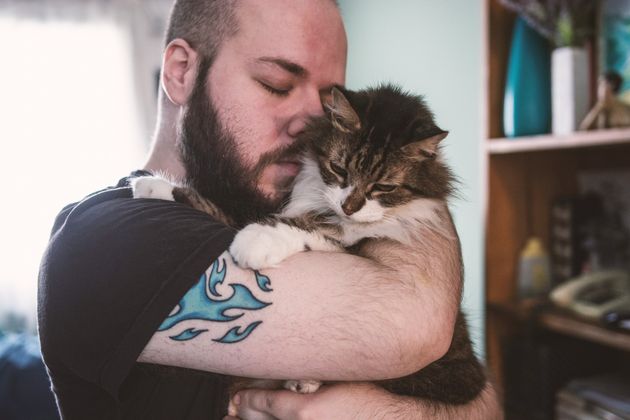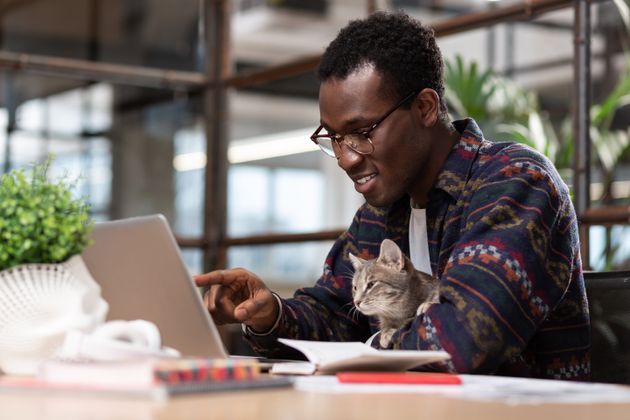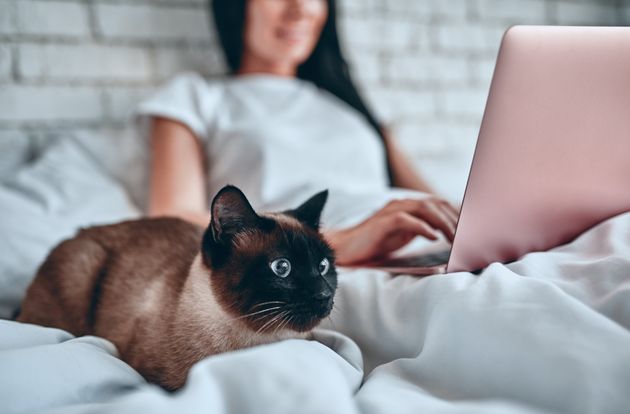
We’re here to guide you through the coronavirus pandemic. Sign up to the Life newsletter for daily tips, advice, how-tos and escapism.
Cats have a reputation for being aloof when it comes to the attention they give their owners. Sometimes it’s easy to feel as though you’re just a glorified cat-food dispenser in human form.
But more than half of cat owners say lockdown has made their bond with their cat(s) even stronger. That’s according to a survey by Direct Line Pet Insurance.
And while some cats do lean towards the more independent side, they’re not as anti-social as we think they are as a species, says animal behaviourist Rosie Bescoby.
“Cats who have been well socialised with humans from an early age are more likely to find human interaction pleasurable, as long as it is the right sort of interaction of course,” Bescoby tells HuffPost UK.
“They will bond with caregivers, sometimes very strongly. New research shows cats can suffer from separation issues too, not just dogs.”
Bescoby, who is a member of the Association of Pet Behaviour Counsellors, says: “For many cats, having ‘their people’ home more has meant warm laps to sleep on, attention to be had whenever it has been demanded, as well as potential access to other things the cat enjoys like food, or outdoor access if owners tend to only let their cat out when they are around to supervise.”
But how can moggy owners actually tell if their beloved feline companion is enjoying this extra company?
Signs your cat is a BIG fan of you
If your cat chooses to spend time near you, that’s a sure-fire sign they’re feeling connected. They might be following you around more often or sleeping near where you’re working, says Bescoby.
Has you cat been seeking interaction more frequently – nudging you with their head, pawing you, rubbing their face on you, or padding across your laptop?
If they’ve been in more physical contact – sleeping on your lap or shoulders, say – this is also evidence of a tighter bond. Even if they don’t sleep near (or on) you, they might choose to nap in areas where your scent is greatest, such as on the sofa or your bed, or in a pile of your clothes.
Another sign of a strong connection built up over lockdown maybe sad to see– and that’s when cats are showing signs of distress. Separation anxiety can change their behaviour – when you leave the house or your cat is unable to gain access to you (for example if you’re sitting in a different room with the door shut). They might become more vocal (meowing or crying), or they might scratch at the carpet or furniture – or urinate indoors.

During lockdown, nearly a third (28%) of pet owners admitted that they spent more than five hours of one-on-one time daily with their pets – breaking this down, 31% of dog owners spent more than five hours with their dog a day, while most cat owners spent between two and three hours with their pet.
Madeline Pike, veterinary nurse at Direct Line, warns that as owners head back to work, some pets may be experiencing separation anxiety, having become used to having their owners around more than usual. Separation anxiety can affect cats of all ages; however it is particularly common in kittens.
How to prevent separation anxiety
“With returning to work, it is important to encourage independent behaviour – so not everything great comes from the owner,” says Bescoby. “Relationships can be maintained using interactive play on a regular basis.”
She recommends providing cats with opportunities to build independence from the environment they’re in, rather than all the good stuff coming from you.
“For example, if you normally feed your cats at set times of the day, consider providing activity feeders that provide both physical and mental stimulation to get the cat to work for their food, as they would naturally have to hunt for their food; or place food around the house or garden for your cats to search for, as they are also natural scavengers,” she says.
“Feeding smaller meals more frequently fulfils their natural eating habits and helps reduce the salience of meal times. A timed feeder removes the association with you providing the food.”

It’s important to interact with your cat(s) but also to encourage independent play – you can do this by providing fun stuff for your cat to hunt and chase.
“Having a variety of textured items – feathers, suede, fur, wool, plastic, cork, polystyrene, paper, the list is endless – that have different sounds and even smells and rotating these on a regular basis, placing them for your cat to find or hanging them from string can enrich your cat’s home environment,” Bescoby adds. “There are loads of games on the market to encourage cats to play independently too.”
Another way to give your cat some newfound independence is to make your home more feline-friendly. Ask yourself: are there high up places for your cat to climb on to? Are there secret hiding places for them to sleep? Are there warm, comfy areas that are off the ground that fulfil all the criteria of your lap?
“Providing access to shelves, tops of furniture or fridges, as well as any empty cardboard box from your deliveries can really help your cat feel more secure without involving you,” says Bescoby.
“This is particularly important in multi-cat households, homes with dogs, or for any cat who exhibits signs of anxiety – because your presence might be the only time they currently feel safe.”



